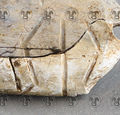SR-5: Difference between revisions
No edit summary |
|||
| Line 30: | Line 30: | ||
Length of the remains about 10.5 cm. The scratches are deep and broad and very clearly legible. The letter preceding {{c||R}} is almost certainly {{c||Φ2}}: The breaking edge, along which the edges of lines can be seen, runs in a tidy angle. Cp. [[index::SZ-2]]. The reading of the sixth letter as Pi is backed by the excellent documentation of the individual name {{w||piθam(n)e}}. The letter after {{c||N}} might be {{c||A}} or {{c||U}}; the latter option is more likely, as no trace of the tip of a bar can be made out. See '''???''' for a discussion on whether the use of {{m||-nu}} vs. {{m||-na}} indicates gender. It is probable that the inscription as given above is complete. | Length of the remains about 10.5 cm. The scratches are deep and broad and very clearly legible. The letter preceding {{c||R}} is almost certainly {{c||Φ2}}: The breaking edge, along which the edges of lines can be seen, runs in a tidy angle. Cp. [[index::SZ-2]]. The reading of the sixth letter as Pi is backed by the excellent documentation of the individual name {{w||piθam(n)e}}. The letter after {{c||N}} might be {{c||A}} or {{c||U}}; the latter option is more likely, as no trace of the tip of a bar can be made out. See '''???''' for a discussion on whether the use of {{m||-nu}} vs. {{m||-na}} indicates gender. It is probable that the inscription as given above is complete. | ||
Below {{c||I}}{{c||R}}, a sequence {{c||S}}{{c||I}}{{c||S | Below {{c||I}}{{c||R}}, a sequence {{c||S|d}}{{c||I}}{{c||S}} is inscribed in the same manner as the inscription proper; the two Sigmas being opposed, it is symmetrical and most certainly non-script. The same goes for the scratches on the back of the object: A sequence ]{{c||K}}{{c||I}}{{c||I}}{{c||I}}{{c||R}}{{c||I}} or similar, length 1.8 cm, damaged along the middle by a broad crack, is applied with a different instrument; also non-script. | ||
Further references: {{bib|Pellegrini & Sebesta 1965}}: 20 f., '''{{bib|Mayr 1965}}''', {{bib|Tibiletti Bruno 1978}}: 235 f. | Further references: {{bib|Pellegrini & Sebesta 1965}}: 20 f., '''{{bib|Mayr 1965}}''', {{bib|Tibiletti Bruno 1978}}: 235 f. | ||
{{bibliography}} | {{bibliography}} | ||
Revision as of 17:13, 2 May 2016
| Inscription | |
|---|---|
| Transliteration: | φ̣]rimapiθamn[ụ |
| Original script: | |
| Variant Reading: | φ̣]rima piθamn[ạ |
|
| |
| Object: | SR-5 antler (antler) |
| Position: | front |
| Script: | North Italic script (Magrè alphabet) |
| Direction of writing: | sinistroverse |
| Letter height: | 1.11.1 cm <br /> – 1.6 cm |
| Number of letters: | 12 |
| Number of lines: | 1 |
| Craftsmanship: | engraved |
| Current condition: | damaged, complete |
| Date of inscription: | 3rd century BC [from object] |
| Date derived from: | archaeological context [from object] |
|
| |
| Language: | Raetic |
| Meaning: | 'Φrima, son/daughter of Piθam(n)e' |
|
| |
| Alternative sigla: | IR 87 LIR SE-8 |
| Sources: | Schumacher 2004: 157, 338 |
Images
|
Object SR-5 antler with inscription SR-5.
|
Object SR-5 antler with inscription SR-5 - rear side.
|
Object SR-5 antler with inscription SR-5 - line 1.
|
Inscription SR-5 - line 2.
|
Commentary
First published in Pellegrini & Sebesta 1965: 12 f. (no. 5). Autopsied by TIR in November 2014.
Images in Pellegrini & Sebesta 1965: 12 (drawing) and fig. 8 (photo), IR (drawing = LIR), LIR (photo).
Length of the remains about 10.5 cm. The scratches are deep and broad and very clearly legible. The letter preceding ![]() is almost certainly
is almost certainly ![]() : The breaking edge, along which the edges of lines can be seen, runs in a tidy angle. Cp. SZ-2. The reading of the sixth letter as Pi is backed by the excellent documentation of the individual name piθam(n)e. The letter after
: The breaking edge, along which the edges of lines can be seen, runs in a tidy angle. Cp. SZ-2. The reading of the sixth letter as Pi is backed by the excellent documentation of the individual name piθam(n)e. The letter after ![]() might be
might be ![]() or
or ![]() ; the latter option is more likely, as no trace of the tip of a bar can be made out. See ??? for a discussion on whether the use of -nu vs. -na indicates gender. It is probable that the inscription as given above is complete.
; the latter option is more likely, as no trace of the tip of a bar can be made out. See ??? for a discussion on whether the use of -nu vs. -na indicates gender. It is probable that the inscription as given above is complete.
Below ![]()
![]() , a sequence
, a sequence ![]()
![]()
![]() is inscribed in the same manner as the inscription proper; the two Sigmas being opposed, it is symmetrical and most certainly non-script. The same goes for the scratches on the back of the object: A sequence ]
is inscribed in the same manner as the inscription proper; the two Sigmas being opposed, it is symmetrical and most certainly non-script. The same goes for the scratches on the back of the object: A sequence ]![]()
![]()
![]()
![]()
![]()
![]() or similar, length 1.8 cm, damaged along the middle by a broad crack, is applied with a different instrument; also non-script.
or similar, length 1.8 cm, damaged along the middle by a broad crack, is applied with a different instrument; also non-script.
Further references: Pellegrini & Sebesta 1965: 20 f., Mayr 1965, Tibiletti Bruno 1978: 235 f.
Bibliography
| IR | Alberto Mancini, "Iscrizioni retiche", Studi Etruschi 43 (1975), 249–306. |
|---|---|
| LIR | Alberto Mancini, Le Iscrizioni Retiche [= Quaderni del dipartimento di linguistica, Università degli studi di Firenze Studi 8–9], Padova: Unipress 2009–10. (2 volumes) |
